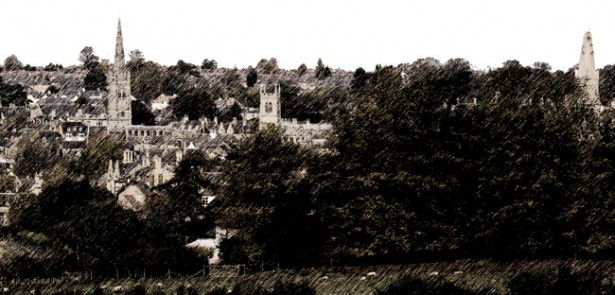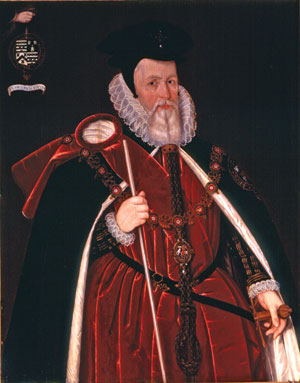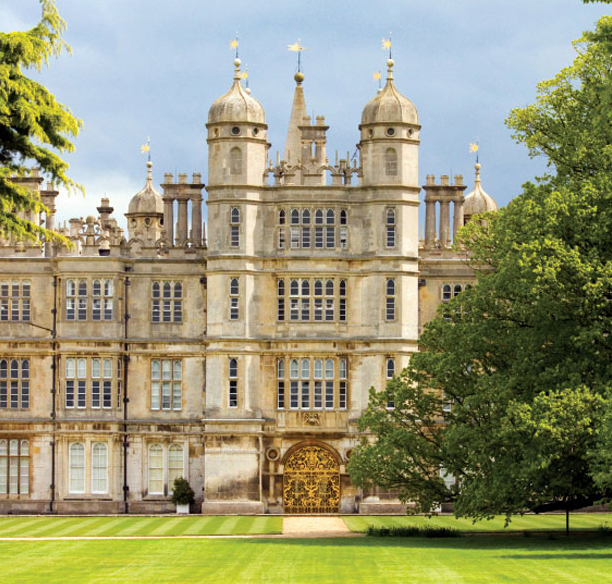Stamford: the town that lives history


Richard Gunn tells the story of Stamford, one of Britain’s best-loved and best-preserved old towns and explains quite how it is such a microcosm of the past, still alive in the present
Known as the ‘finest stone town in Britain’, Stamford is an extraordinary place that seems to have reached the 18th century and simply decided to stop there; a genteel and elegant snapshot of the past, conserved for the present and future. But behind this impressive façade lies struggle and strife; indeed, had Stamford not been so impoverished for so much of its existence, or been allowed to develop more by those who held power and money there, it’s likely that the character and architecture so prized today might have disappeared long ago. As a person in modern times, be thankful that it didn’t. But also be thankful that you didn’t have to live through some of the centuries that turned it into such an architectural jewel.
The origins of Stamford are lost in legend – literally. In Geoffery of Monmouth’s Historia Regum Britanniae, a 12th century account of the Kings of Britain, a Bladud is mentioned. Rather less famous than the son he sired – Shakespeare’s King Lear – he supposedly reigned for 20 years from BC863. Bladud returned from Athens to rule the fledgling kingdom and decided to establish a university based on Greek principles.
He built the schools, like Attic’s then, And gave them lands to maintain those, Who were accounted learned men, And could the grounds of arts disclose. The town is called Stamford yet…

 As wonderful a story as this is – Stamford as Britain’s first centre of learning – there’s no evidence to suggest it’s true. The first real proof of human activity comes from around AD45, when the Romans started building Ermine Street from London to Lincoln and York. It passed through what is now Burghley Park and forded the River Welland – a plaque now marks the spot and the traces of the crossing can still be seen – and was used by Queen Boudica and her tribe of irate Icenis when she pursued the vanquished Roman Ninth Legion. This ford – or one of its nearby companions in the area – gave the future town its name, meaning a ‘stony ford’.
As wonderful a story as this is – Stamford as Britain’s first centre of learning – there’s no evidence to suggest it’s true. The first real proof of human activity comes from around AD45, when the Romans started building Ermine Street from London to Lincoln and York. It passed through what is now Burghley Park and forded the River Welland – a plaque now marks the spot and the traces of the crossing can still be seen – and was used by Queen Boudica and her tribe of irate Icenis when she pursued the vanquished Roman Ninth Legion. This ford – or one of its nearby companions in the area – gave the future town its name, meaning a ‘stony ford’.
Stamford then dropped out of the limelight for almost a millennia, before popping up again in 918 when King Edward of Wessex built a southern fortress as an offensive against the Vikings who had settled on the northern side of the river. Tussles between Danes and Anglo-Saxons continued until, in the 950s, Stamford became one of the five controlling boroughs of Danelaw – legal, administration and court centres set up to rule over the areas of England that the Norse invaders had made their homes away from home. Ultimately though, Stamford failed to reach the same prominence as its other four Danelaw contemporaries, Leicester, Derby, Nottingham and Lincoln, all of which became county towns. It lost much of its land and influence when Lincolnshire was formed in the early 11th century, with Peterborough making off with territory to the south.
Nevertheless, the Domesday survey of 1086 after the Norman Invasion found Stamford to be a large and prosperous town of 2,000 to 3,000 residents, making it one of the 10 largest urban areas in the country. It was famous for its Stamford Ware pottery, sold throughout Britain and Europe. The Normans had quickly established control over what was quite a prize, building a castle there in 1068 – the remains of which now support the bus station. Conflicts within the Norman hierarchy led to this castle being besieged and captured in 1153 by Henry of Anjou, as part of his successful campaign to become King Henry II of England. This coincided with the decline of the pottery industry and the growth of the wool and cloth trade, aided by huge flocks of sheep acquired by nearby Crowland Abbey and the ability of the River Welland to be navigated by flat-bottomed boats carrying goods for export to the ports of Boston, King’s Lynn and Spalding.
A transport link of a different kind would soon have even greater significance though. In 1170, the River Trent was bridged at Newark, meaning that the main route from London to York – the Great North Road – switched from passing through Nottingham to going through Stamford. A new bridge was built across the Welland to cater for the increased traffic – this lasted until 1845 when it was replaced by the one that still carries vehicles today. Religious establishments – for weary travellers seeking spiritual rest along their journey – also proliferated. Even today, Stamford is notable for the quantity and quality of its churches and their impressive architecture. But there was not complete religious harmony in the town; in 1189, anti-Semitic sentiment sweeping through the country prompted attacks on Stamford’s Jewish population, prompting them to shelter for their lives in the castle.
Happier times were provided by the town’s Mid-Lent Fair, established during Danelaw times but by then an event of international significance, attended by merchants and Royal servants from all over Europe. This three week orgy of trade and exuberance, mentioned in Shakespeare’s Henry IV Part II, is still held today, although nowadays, it’s a huge funfair that takes over the town for almost a week. Somewhat more notorious, to modern minds anyway, was Stamford’s bull-running festival. Local myth has it that the practice started when local baron William de Warenne saw two bulls fighting in what is now The Meadows. One of them escaped into the town and ran amok, pursued by several butchers and William himself on horseback. He enjoyed it so much that he decreed a bull should be chased through the town every 13 November thereafter. That was until 1839 when a campaign by the Society for the Prevention of Cruelty to Animals – a year away from receiving its Royal prefix from Queen Victoria – forced the event to end, against the wishes of many of the residents who regarded it as a ‘traditional, manly, English sport; inspiring courage, agility, and presence of mind under danger.’ It’s unlikely the bulls felt the same – they were always killed at the end.
By the 13th century, Stamford’s population had spiralled to 5,000, making it one of England’s largest towns. But it was a beleaguered place; overseas wars and the decline of the cloth trade due to cheaper imports had taken some of its earlier prosperity away. Outbreaks of the Black Death in 1349, 1361 and 1375 only exacerbated the problems, wiping out a significant proportion of the population and leaving many properties deserted. Stamford also suffered trouble from a somewhat unusual source; the academics of Oxford and Cambridge. Major arguments in Oxford had pitched town against university and college against college; so much so that a group of masters and students left in 1333 and tried to set up a rival university in Stamford. It lasted a mere two years before Oxbridge pressure caused it to be disbanded. For centuries afterwards, Oxford banned its students from lecturing or attending lectures in Stamford. The dispute only formally ended when, in 1890, Oxford’s Brasenose College removed the ancient ‘Brazenose’ door knocker from a 13th century Stamford house and repatriated it back to where the 14th century rebels had supposedly ‘borrowed’ it from as a symbolic transfer of academic power. Oxford students are now free to do whatever they like in Stamford. Well, within reason…
During the following century, the town was sacked during the Wars of the Roses in 1461, with an uprising against King Edward IV resulting in a battle being fought just outside the town in 1470. Life grew more settled after this; one rich local wool merchant becoming a town benefactor whose philanthropic legacy exists to this day. William Browne had no male heir to pass his wealth onto. Instead, he spent it on good works for the town; Browne money rebuilt All Saints Church into the impressive and flamboyant form it remains in today and he also established the almshouses on Broad Street that are still a centrepiece of the town’s historic architecture. Known as Browne’s Hospital, this 1485 institution still fulfils its original function, as a free hospice and home for 12 of Stamford’s poor and elderly.
 King Henry VIII’s Dissolution of the Monasteries from 1536 to 1541 caused major change. The break with the Roman Catholic Church saw many town religious establishments either closed completely or combine with others. An uprising in Lincolnshire against the Reformation, known as the Pilgrimage of Grace, had little effect against this, especially when the rebels surrendered to the Duke of Suffolk in October 1536 at Stamford, provoking Henry VIII to dub the county as “one of the most brute and beastly of the whole realm.”
King Henry VIII’s Dissolution of the Monasteries from 1536 to 1541 caused major change. The break with the Roman Catholic Church saw many town religious establishments either closed completely or combine with others. An uprising in Lincolnshire against the Reformation, known as the Pilgrimage of Grace, had little effect against this, especially when the rebels surrendered to the Duke of Suffolk in October 1536 at Stamford, provoking Henry VIII to dub the county as “one of the most brute and beastly of the whole realm.”
 Much of the land seized from the monastic institutions ended up in the hands of the family that will always be most associated with Stamford; the Cecils. Originally merchants and lawyers from Hertfordshire, the Cecils began to rise in national politics with the most meteoric ascent achieved by William Cecil. Born in 1520, he became chief adviser to Queen Elizabeth I and arguably the most powerful man in the kingdom. He was made Lord Burghley in 1571, taking his name from the grand mansion he was building for himself just outside Stamford. Largely complete by 1587, Burghley House today is recognised as one of Britain’s foremost Elizabethan stately homes and the jewel in Stamford’s opulent architectural crown. The Cecils dominated Stamford for centuries; from 1504 to 1589, five members of the family served as the town’s MPs and when William died in 1598, he was buried in St Martin’s Church, in a canopied tomb that dwarfed everything else in the building. While the extent of Cecil control did stagnate some aspects of Stamford’s development and economy, the family also financed projects such as the town hall and gaol at the north end of the bridge, and the almshouses – Lord Burghley’s Hospital – on its southern side. The bridge was itself repaired in 1570 with William Cecil cash. Of course, as he exacted the tolls from those passing over it, there was some financial incentive to do so…
Much of the land seized from the monastic institutions ended up in the hands of the family that will always be most associated with Stamford; the Cecils. Originally merchants and lawyers from Hertfordshire, the Cecils began to rise in national politics with the most meteoric ascent achieved by William Cecil. Born in 1520, he became chief adviser to Queen Elizabeth I and arguably the most powerful man in the kingdom. He was made Lord Burghley in 1571, taking his name from the grand mansion he was building for himself just outside Stamford. Largely complete by 1587, Burghley House today is recognised as one of Britain’s foremost Elizabethan stately homes and the jewel in Stamford’s opulent architectural crown. The Cecils dominated Stamford for centuries; from 1504 to 1589, five members of the family served as the town’s MPs and when William died in 1598, he was buried in St Martin’s Church, in a canopied tomb that dwarfed everything else in the building. While the extent of Cecil control did stagnate some aspects of Stamford’s development and economy, the family also financed projects such as the town hall and gaol at the north end of the bridge, and the almshouses – Lord Burghley’s Hospital – on its southern side. The bridge was itself repaired in 1570 with William Cecil cash. Of course, as he exacted the tolls from those passing over it, there was some financial incentive to do so…
The Cecils’ personal wealth wasn’t reflected in the fortunes of the town though; the wool trade continued its decline, with leather-working and hemp-making filling in the gaps, albeit not enough to stop Stamford being described as a ‘decayed’ during the middle of the 16th century. The River Welland silted up, preventing boats from reaching the town, and the Great North Road brought large numbers of vagrants to the town, searching for work and attracted by the many inns. Chief among these was The George, by the main bridge. Dating back to the Danelaw days of the 10th century, it had started out as a religious institution for the righteous on their way to the Holy Land, evidenced by the remains of the hospital of the Knights of St. John of Jerusalem under what is now the cocktail bar! By the 16th century though, it was yet another local Cecil property – the family coat of arms still hangs over the main entrance.
In 1602, the town’s finances were so bad that it was excused from paying tax. Population had fallen to around 2,000, meaning it had fewer residents than at the time of Domesday, over 500 years previously. An outbreak of the plague in 1604 devastated numbers even more; 600 people died and large tracts of the town fell derelict. A further blow was dealt by the start of the Civil War in 1642. Stamford’s loyalties were with the Royalist cause, although the town tried to stay out of the conflict on the whole. That didn’t stop Burghley House being shelled then seized by Oliver Cromwell’s Parliamentarian forces in 1643, and the King, Charles I, sheltered in Stamford while en route to seek support from Scotland in 1646. He was executed in 1649, but Cromwell’s Commonwealth only lasted until 1660, when the monarchy was restored under Charles II.
 Oliver Cromwell inspects the body of King Charles I following his execution in 1649
Oliver Cromwell inspects the body of King Charles I following his execution in 1649
Peace and a more stable political climate finally brought back the prosperity that Stamford had been craving for so long. The construction of the Welland Navigation Canal allowed trade barges to return and land travel increased as long distance coach travel took off. On the Great North Road halfway between London and York, Stamford was ideally positioned to exploit this. Initially two days’ travel from either city, turnpike road improvements soon meant it was only nine hours away from the capital, making it the natural choice for travellers to stay overnight; taverns and hotels proliferated, with The George evolving to become a major coaching inn well-known throughout the land. A peak of 40 coaches passed through Stamford daily, bringing a lot of commerce to the town. The famous ‘The George of Stamford’ sign that still spans St Martin’s outside the hotel was put up as a reminder to coachmen to start slowing their horses after the long descent into the town – for if they didn’t, the River Welland was a more uncomfortable stop. The now-iconic emblem also served as a greeting to passengers, but it also had a darker symbolism; its appearance mimicked that of a gallows, a warning to local highwaymen – such as Dick Turpin and Tom King – that they were much less welcome than those they preyed upon. The George still retains many of its coaching inn elements, including doors marked ‘London’ and ‘York’ either side of the entrance – these were once the waiting rooms for travellers. Modern air travel owes this era a nod for its invention of luggage limits; passengers were permitted 14.5lbs of baggage free. Anything over, and the charge was three pennies per pound extra. Ryan Air, eat your heart out.
The influx of travellers – many of them staying overnight – also brought new shops to the centre, to capitalise on this new custom from the coaching inns, reversing the previous sense of decay. In effect, Stamford became a little like a busy modern airport hub or major railway station with retail outlets attached to keep those in transit amused and somewhat lighter of cash than when they arrived. In place of information screens, there was the local press – the Stamford Mercury boasts that it is Britain’s oldest continuously published newspaper, having been founded in 1695 and still going today.
Britain’s first national census in 1801 revealed the town’s population had bounced back to 5,000 – the same as it had been in the 13th century, before economic depression and disease cut such swathes through its inhabitants. It was becoming a rich little place, too; the newly-affluent middle classes building many fine structures during the Georgian era, several of which remain today and give Stamford its distinct and striking stone-clad character. Even as far back as 1697, Stamford was already noted for its handsome nature; pioneering female traveller Celia Fiennes – regarded as the first woman to have visited every county in Britain – called it ‘as fine a built town all of stone as may be seen…much finer than Cambridge.’ An early 19th century landmark – and still one today – was the neo-classical Stamford Hotel in St Mary’s Street, its columned façade towering above neighbouring structures. As beautiful as it appears now, it was a controversial structure when new, rather like putting a modern office block in the centre of a picturesque village. But it was intended as such; a symbol of rebellion against the power of the Cecil family – for their control over almost every aspect of Stamford life was still strong and stifling development.
Paradoxically, had the Cecil grip not been so iron, then Stamford might have changed far more and been much less the historic tourist trap it is today – the industrialisation that swept across the country during the 19th century seemed to by-pass Stamford almost completely. Because so much land was Cecil-owned, they could effectively dictate what was built and where, preventing the town from expanding beyond its traditional borders. This made the relationship between those in the town and Brownlow Cecil, the Marquess of Exeter and the main overlord of all things Stamford, very prickly. The Marquess’s coach was attacked in the streets, the Stamford Mercury condemned him in print and such was the spirit of revolution in the air that armed guards were stationed at Burghley House and cannons mounted on the roof. Mobs and riots became commonplace, especially around election time when, invariably, it was the Cecil-backed Tory candidates (Stamford, a ‘pocket borough’, had two MPs, a right not given to many much larger towns) who won, with bribery, intimidation and threats of eviction often playing a significant part in the victories.
When plans were drawn up for a railway line from London to the north east in 1844, it passed close to the town. The townspeople were all for it, the Marquess less so, and ultimately, Peterborough got the main railway instead of Stamford, the engineering work across the fens being an easier option. Compensation was in the form of a branch line, from Peterborough, that ultimately linked up with Leicester. It was diverted through the land belonging to the Marquess who undoubtedly benefitted financially and even got the Midland Railway to foot the bill for rebuilding the town bridge from its single carriageway 12th century form as part of the deal. Before promptly reintroducing tolls again. At least the station was finished in suitably Elizabethan style to complement what was around it, even if the Marquess did insist on his coat of arms gracing it. His attitude towards railways did alter in later years; he supported a connection to the main East Coast Main Line at Essendine and also backed a branch from Stamford to Wansford, the current base of the Nene Valley Railway. It made little money though, and closed in 1929.
Nationwide railways did cause coach travel to collapse, and Stamford’s fortunes went into a steep decline again. Inns closed, shops shut, and the Welland Navigation Canal became unusable.
The line through Stamford did bring in some recompense in the form of new trade and visitors, but because it was only a branch rather than a main route, it couldn’t make up for what had been lost when the coaches died out.
 The influence of the Cecils was finally eroded in 1867 when the Marquess died and the Second Reform Act was introduced, making political representation much fairer, including secret ballots that made intimidation harder. Cecil family debts meant that land had to be sold or enclosed, which allowed Stamford to finally expand, with new houses and factories. The Industrial Revolution finally seemed to be catching up with Stamford. Companies started producing agricultural machinery, oil-fired engines, brick, wagons and carriages; at the turn of the 20th century, the town even had its own car plant. Local man John Henry Pick built his first car in 1899, his Pick Motor Company was established in 1900, with a factory directly opposite the George Hotel. However, it floundered in 1925, unable to weather the depression and competition from small cars such as the Austin Seven. Yet despite Stamford trying to catch up with the modern world, it was unable to compare to neighbours like Peterborough, Grantham and even Spalding, where progress had got underway much earlier.
The influence of the Cecils was finally eroded in 1867 when the Marquess died and the Second Reform Act was introduced, making political representation much fairer, including secret ballots that made intimidation harder. Cecil family debts meant that land had to be sold or enclosed, which allowed Stamford to finally expand, with new houses and factories. The Industrial Revolution finally seemed to be catching up with Stamford. Companies started producing agricultural machinery, oil-fired engines, brick, wagons and carriages; at the turn of the 20th century, the town even had its own car plant. Local man John Henry Pick built his first car in 1899, his Pick Motor Company was established in 1900, with a factory directly opposite the George Hotel. However, it floundered in 1925, unable to weather the depression and competition from small cars such as the Austin Seven. Yet despite Stamford trying to catch up with the modern world, it was unable to compare to neighbours like Peterborough, Grantham and even Spalding, where progress had got underway much earlier.
There were further in-roads into Stamford’s genteel and Georgian air, with Stamford Football Club formed in 1896 and turning professional in 1910. By 1913, the town had two cinemas and the relationship between the town and the Cecils of Burghley House had improved considerably, the family now somewhat humbled by financial woes. The First World War saw thousands of men from the area go off to fight, many of them never to return. Stamford’s industries also turned themselves over to the war effort. Recovery afterwards was slow – there was high unemployment and recession in Stamford, and in an incident the town might prefer to forget about: fascists were elected to the town council during the 1920s, the only place in the UK this ever happened. Before long though, the country was back at war with the fascists of Hitler’s Germany; Stamford suffered only slightly in air raids, perhaps because of the close vicinity of Burghley House which Luftwaffe head Hermann Goering had earmarked as his personal residence if Britain was invaded and thus ordered to be left undamaged.
Burghley House; a Stamford landmark
Postwar, Stamford’s focus shifted towards tourism. Its untouched, ancient atmosphere, the by-product of Cecil obstinacy towards progress and industry, saw it designated the first conservation area in England in 1967. The peaceful nature of the town was helped by the A1 bypass in 1960, which removed the traffic jams that had choked the centre throughout the first half of the 20th century, although anybody down by the bridge during a weekday rush-hour or a summer weekend might argue that point. The opening of Burghley House to the public has brought many to the town who might not have otherwise come: the estate attracts around 70,000 to 100,000 people per year. The stunning Rutland Water, just down the road, has also proved beneficial. Extra stimulus has come from Stamford’s exposure on the big and small screen: in 1994, the BBC’s Middlemarch was filmed in the town and more recently, the town doubled as Jane Austen’s Meryton in the 2005 cinematic production of Pride and Prejudice starring Keira Knightley. Even Top Gear has used it.
Stamford today is a vibrant, thriving, busy place, albeit one that has to face the challenges of the 21st century and straitened economic times just as much as anywhere else in the UK. However, it does so against one of the most beautiful urban backdrops in Britain, one that is beloved of both those who live there and those who visit and become entranced by Stamford’s magic.
















